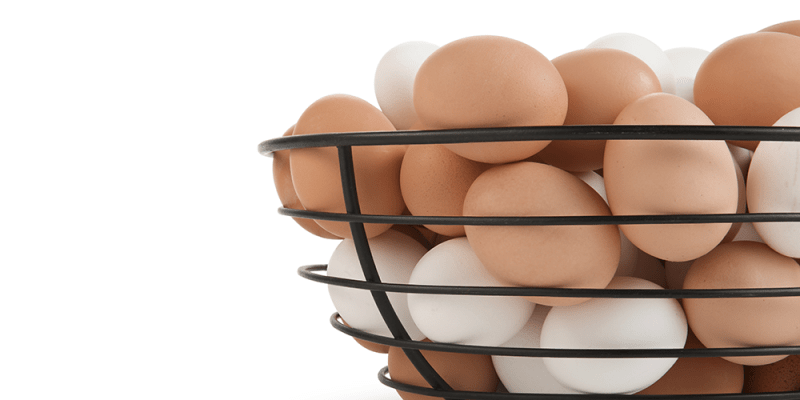When and How to Wash Eggs


I admit it: I’m in it for the eggs. I love my birds, but what I love most is that daily contribution to my breakfast plate. Raising hens provides a means of ensuring the welfare of animals that provide our sustenance and the processes utilized to treat our food. By taking control of your food production, you also accept responsibility for food safety. Thoughtful, proper egg handling techniques are essential to preventing inadvertent illness.
Difference in approach
Egg-borne disease is a sincere concern for every size of egg producer. The FDA estimates consumption of contaminated eggs causes 142,000 cases of Salmonella annually. The USDA regulatory strategy assumes there will always be some contamination that requires action. To ensure we have a safe food supply, all major U.S. producers are required to wash and sanitize their eggs.
In contrast, the European Union discourages—and even prohibits—the washing of eggs prior to sale. Instead of assuming contamination, the European approach encourages producers to ensure clean eggs throughout the process. By raising your own layers, you get to choose which strategy to employ.
Clean eggs start in the coop
Excellent chicken husbandry is an absolute requirement to create safe eggs. All eggs are porous—there are microscopic holes throughout the shell where bacteria can enter. The most likely route for bacteria to contaminate your eggs occurs when the shell surface comes in contact with feces. The chance that your hens’ eggs will be in the vicinity of poop is largely controlled by the design and care of your coop.
Proper nest box management is the foundation of clean egg production. For key nest box considerations, see “Nine Tips for a Tidy Nest Box” on page 17. Additional considerations include rodent control and general bird health. Rodent fecal material can serve as the initial pathogen source. When the hen eats feed contaminated with rodent droppings or urine, the bacteria then colonizes inside your bird, possibly even in the egg-producing oviduct.
A stressed hen will have a suppressed immune system and is more likely to harbor disease. Plus, any chicken with loose stool or diarrhea will be messier on the back end, which could smear onto your eggs.
Egg collection matters
Every hour that an egg sits in a nest box increases the risk of breakage, contact with contamination, and a chance for the bacteria present to proliferate. Large commercial operations have the convenience of constant collection via conveyer belt. Still, even in the smallest flock, eggs should be collected three times a day for reasonable egg safety. Middle of the day collection may not be practical for a hobbyist with normal work hours. However, since most hens lay sometime in the morning, mid-day collection is also the most important.
When you collect an egg that has fecal material on it, you have already lost the opportunity for safe, homegrown food. Soiled eggs should be disposed of promptly and not be allowed to come into contact with your clean, sound eggs. Eggs with a slight amount of dry material such as dirt, adhered feathers, or shavings should be dry wiped immediately after collection. Do not use any moisture when wiping, and any egg that doesn’t readily wipe clean should be discarded or stored in a separate container for later washing.
The power of bloom
Every egg is laid with an outer waxy cuticle, commonly called the bloom. This functions as a layer of protection around the entire shell—including those microscopic pores. The bloom insulates the outside of the egg and decreases the amount of bacterial movement and gas exchange that occurs across the shell.
While the bloom is important, it is not impervious. If you keep a messy nest with any direct feces-to-shell contact, your egg will harbor bacteria regardless of bloom status. The more open shell pores on bloomless eggs will result in both faster egg aging and a significant increase of the risk of infection.
We are fortunate to live in an era when your flock can produce a fantastic variety of egg colors. However, a darker egger does not make a superior bloom. This bloom is equally present on eggs of all hues.
Any and all wet cleaning removes the function of this beneficial layer. In commercial operations, spraying a final layer of mineral oil serves as a replacement bloom to extend the quality and shelf life of commercial eggs. The equipment required to achieve this oil mist is not practical on a small scale. Once you wet clean an egg, you sacrifice the benefits of the bloom.
The right wash
For backyard birds, avoiding the need for a wet washing is generally the safest approach.
Improper egg cleaning does more harm than good. In fact, submerging an egg in water for cleaning is legally prohibited, and for good reason.
For eggs immersed in water, the fluid functions as an open road for bacteria to stream through the shell’s pores into the egg. To prevent this situation, always clean your eggs under constantly running water that is at least 20°F warmer than the eggs. The increased warmth causes swelling and pushes the internal egg membranes against the inner shell surface, physically blocking bacterial entrance. Be careful, as water with too great a difference in temperature from the egg can cause shell cracking.
All contents of your water can influence the wholesomeness of your eggs. Only potable, or safe to drink, water should be utilized for egg cleaning. If your water has more than two parts per million (or ppm) of iron, it can promote bacterial proliferation in eggs. Any soap used must be generally recognized as safe (or GRAS) by the FDA and approved for food surfaces—visit the FDA website for more information. For backyard flocks, unscented, dye-free dishwashing detergent is usually considered acceptable.
Washing eggs is only the first of three cleaning steps. While washing removes the significant material on the shell’s surface, some microscopic bacteria will remain on the now bloomless egg surface. Therefore, after washing, eggs should be rinsed with water and then sanitized. Remember to use only running water at each step of this process and keep the water at 20°F warmer than current egg temperature.
The most commonly used sanitizing agent is chlorine bleach. Adding a half of a tablespoon of bleach per gallon of water will produce an appropriate 100 ppm solution. At this concentration, there should be no appreciable odor or flavor impact. After sanitizing, all eggs should be dried in a manner that prevents contact with any sitting water, including condensation. Placing an egg straight into a carton can easily trap residual moisture around the clean egg. A rack can be used to allow the eggs to dry before cartoning.
Chill power
Storing an egg at a refrigerated temperature has a profound impact on the rate of growth and proliferation of disease causing bacteria, including Salmonella. The longer the time between egg production and consumption, the more critical this consideration becomes. Due to bacterial replication rates, the risks of leaving eggs at room temperature are exponential. In other words: Not refrigerating your eggs for one day has some risk, but not refrigerating an egg for two days can be hundreds of times riskier.
Bacterial location also plays an important role. Initial contamination starts out in the albumin (or egg white), which is a mediocre growth medium. When your eggs wait a few days, bacteria can make their way into the nutrient rich yolk. For yolk bacteria, a temperature difference of just 10°F makes a thousand-fold difference in the daily growth rate.
Another refrigeration plus: Storing eggs at a decreased temperature preserves freshness. Every egg consumer can readily appreciate the flattening of texture as an egg ages. This is also evident by the size of the air cell. Aging processes—such as the degradation of the egg white—will occur at a slower rate due to less thermal energy present.
Eggs that experience a variety of temperatures have a unique risk for food safety. Going from a cool environment to a warm environment can cause condensation on the shell. The subsequent water droplets facilitate the movement of bacteria into the shell. This is the rationale for room-temperature egg sales in Europe. Still, unless they are consumed within about a day, eggs should be refrigerated once you bring them home.
The bloom and refrigeration both impact the speed at which an egg can become unsafe to eat. The bloom greatly decreases the chance of contamination of an egg that was never overtly soiled. Refrigeration decreases the speed of growth of any bacteria present. An egg without a bloom should always be refrigerated, but the benefits of refrigeration do not depend on the bloom. Unless you’re within a couple days of eating them, store all eggs in the fridge.
Threat of law
Regardless of your personal philosophy, you are taking legal and financial responsibility for any potential foodborne illness if you sell your eggs. In addition to USDA regulations, state and sometimes local ordinances may dictate how you have to process your eggs. Beyond these egg-production regulations, additional rules from public health or environmental health departments oversee the sale of eggs.
Depending on your area, full cleaning and sanitizing may be legally required. Refrigeration is almost universally required throughout the U.S., although there can be short-term exceptions for farmer’s market stalls.
Take home message
Everyone should enjoy the delicious benefits of home grown eggs. With thoughtful chicken and egg husbandry, you can ensure eggs remain a healthy component of your daily diet.
- Maintain your nests and coop to create clean eggs that never contact poop
- Keep your birds healthy and collect eggs regularly
- If you decide to wash your eggs, use an appropriate protocol
- Unless you will consume your egg promptly, utilize the benefits of refrigeration
Nine Tips for a Tidy Nest Box
1 Bigger isn’t always better – Keep nest boxes about one-foot by one-foot square. The snug fit will discourage chicken activity and chance of egg breakage. Similarly, the size ensures only one bird fits at a time.
2 Set the mood – Place your box in a calm corner away from the door. This will make the nest more appealing and decrease bird movement within the box. Birds prefer a dim area to deposit their cherished eggs.
3 Soft matters – Ensure the substrate that is in the box is softer than any surrounding option or your birds may choose to lay elsewhere.
4 Keep it clean – Completely change any bedding in the box at least weekly. This will ensure a clean and dry environment while also decreasing the likelihood of mites.
5 Between floor and roost – Have the nest box entrance off the ground to prevent scratching and activity. However, ensure that there are ample roosts available at a greater elevation or you may get birds sleeping (and pooping) from the edge of the box.
6 Five at most – Provide at least one nest box per five hens or there may not be a box available when a hen needs it most.
7 Taper the top – Have an angled roof on your nest boxes with the highest side opposite the nest box entrance. This will prevent birds from roosting on—and defecating from—the top of the box.
8 Scrub-able structure ��– While wood is the traditional box material, bacteria and ectoparasites can securely hide within crevices beyond the reach of any cleaning protocol. Purchasing or creating a box that is made from hard plastic or metal gives you the option of removing the box and performing a thorough disinfection.
9 Listen to your birds – If your birds are only using a couple of the possible boxes available, they are sending you a clear signal. Evaluate what makes the favored nest boxes appealing and modify the other boxes to have similar appeal.
Tags:Excellent Eggs

Chicken Whisperer is part of the Catalyst Communications Network publication family.












